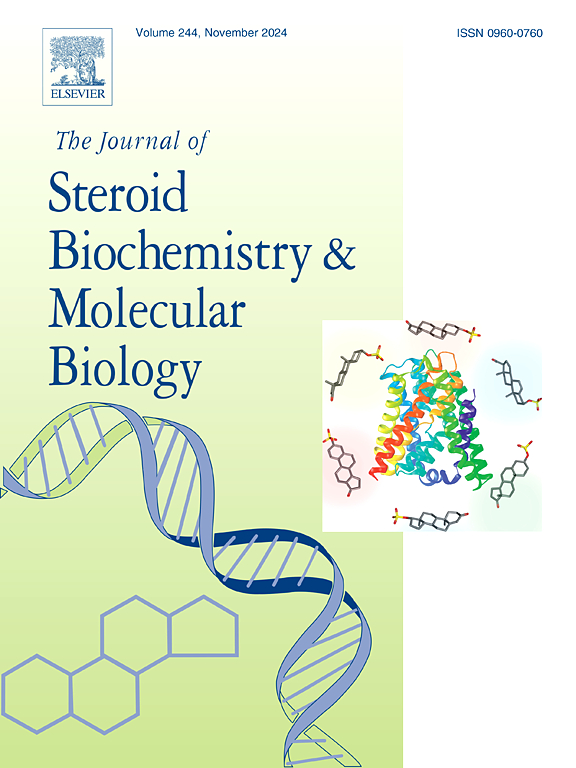口服和经皮给药睾酮后尿液中内源性类固醇硫酸盐和葡萄糖醛酸苷的评价。第一部分:男性参与者。
IF 2.5
2区 生物学
Q3 BIOCHEMISTRY & MOLECULAR BIOLOGY
Journal of Steroid Biochemistry and Molecular Biology
Pub Date : 2025-09-29
DOI:10.1016/j.jsbmb.2025.106870
引用次数: 0
摘要
提高成绩的药物睾酮(T)的检测仍然是兴奋剂控制分析中的一个重大挑战。通过类固醇运动员生物护照(ABP)进行纵向监测是一种有价值的T检测工具,但需要进一步研究以提高其有效性。内源性合成代谢雄激素类固醇(EAAS)的II期代谢物,包括葡萄糖醛酸酯和硫酸盐,作为类固醇ABP的潜在新生物标志物越来越受到关注。值得注意的是,硫酸盐代谢物对口服、透皮和肌内给药具有更高的敏感性,与传统生物标志物相比,具有更大的检测窗口。然而,在将这些有前景的生物标志物纳入尿类固醇分析之前,有必要解决与不同T给药方法相关的代谢变化,以及与种族和性别相关的差异。在这部分研究中,我们研究了口服和透皮给药T对男性参与者常规生物标志物和II期EAAS代谢物的影响。硫酸盐比表明对多次给药十一酸睾酮(TU)片和T凝胶的敏感性更高,与传统的类固醇生物标志物相比,显著延长了检测时间。具体来说,硫酸雄酮(as)/硫酸睾酮(TS)和硫酸表雄酮(EpiAS)/TS等硫酸盐比率使最后一次口服TU剂量后平均20天和最后一次透皮T应用后至少16天的检测成为可能。这些发现提供了进一步的证据,将硫酸盐EAAS代谢物纳入类固醇谱分析可以提高检测能力。对于高级T兴奋剂检测,硫酸盐代谢物应被认为是类固醇谱中必不可少的生物标志物。本文章由计算机程序翻译,如有差异,请以英文原文为准。
Evaluation of endogenous steroid sulfates and glucuronides in urine after oral and transdermal administration of testosterone. Part I: Male participants
The detection of the performance-enhancing drug testosterone (T) remains a significant challenge in doping control analysis. Longitudinal monitoring through the steroidal Athlete Biological Passport (ABP) is a valuable tool for T detection, but further research is needed to enhance its efficacy. Phase II metabolites of endogenous anabolic androgenic steroids (EAAS), including glucuronides and sulfates, have gained increasing interest as potential new biomarkers for the steroidal ABP. Notably, sulfate metabolites have demonstrated higher sensitivity to oral, transdermal, and intramuscular T administration, with extended detection windows compared to traditional biomarkers. However, before incorporating these promising biomarkers into urinary steroid profiling, it is essential to address the metabolic variations associated with different T administration methods, as well as differences related to ethnicity and sex. In this part of the study, we investigate the effects of oral and transdermal T administration on conventional biomarkers and phase II EAAS metabolites in male participants. Sulfate ratios indicated higher sensitivity to multiple administrations of testosterone undecanoate (TU) tablets and T gel, significantly prolonging detection times compared to conventional steroid profile biomarkers. Specifically, sulfate ratios such as androsterone sulfate (AS)/testosterone sulfate (TS) and epiandrosterone sulfate (EpiAS)/TS enabled detection for an average of 20 days following the last oral TU dose and at least 16 days after the last transdermal T application. These findings provide further evidence that incorporating sulfate EAAS metabolites into steroid profiling enhances detection capabilities. For advanced T doping detection, sulfate metabolites should be considered essential biomarkers in the steroid profile.
求助全文
通过发布文献求助,成功后即可免费获取论文全文。
去求助
来源期刊
CiteScore
8.60
自引率
2.40%
发文量
113
审稿时长
46 days
期刊介绍:
The Journal of Steroid Biochemistry and Molecular Biology is devoted to new experimental and theoretical developments in areas related to steroids including vitamin D, lipids and their metabolomics. The Journal publishes a variety of contributions, including original articles, general and focused reviews, and rapid communications (brief articles of particular interest and clear novelty). Selected cutting-edge topics will be addressed in Special Issues managed by Guest Editors. Special Issues will contain both commissioned reviews and original research papers to provide comprehensive coverage of specific topics, and all submissions will undergo rigorous peer-review prior to publication.

 求助内容:
求助内容: 应助结果提醒方式:
应助结果提醒方式:


